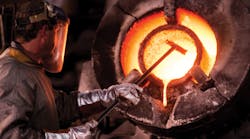Refractory engineers are under constant pressure to increase the performance of melting, holding, and transfer vessels, in order to maximize energy efficiency. Although there are many materials that can enhance that efficiency, many furnaces lose heat during melting, through flue gas, excess moisture in fuel, continued opening of the furnace door, etc. This prevents many metalcasting operations from realizing maximum energy efficiencies, and increases their attention on the reliability of furnace insulation and lining.
In most metalcasting operations melting systems consume more energy than any other piece of equipment, making it essential that all the available correct measures are put in place to realize as much energy efficiency as possible. An efficient furnace is critical to reducing overall maintenance costs and ensuring that foundries and diecasters run smoothly, without unnecessary loss of revenue caused by downtime.
The right refractory materials deliver a protective and insulating layer of heat resistance to the inside of the shell, hearth, and tapholes of a furnace. Not only does this protect furnace parts from extreme heat, but it also prevents excessive heat loss and can lead to greater overall energy efficiency.
However, identifying the need for new furnace lining and installing the right material is not easy. To do it right, here are five primary tips for maximum furnace lining efficiency:
1. Use IR thermography to inspect the existing lining — Ensuring lining quality is critical to protecting the structure from excess heat and minimizing instances of heat loss. Furnaces that have developed cracks over time are prone to leakage. Some may also have design issues that are not visible from the outside, which can cause heat loss issues over time.
In order to identify hot spots where the unit is leaking or reducing performance, infrared thermography scans are essential. This typically involves pointing an infrared camera at several points on the furnace casing to analyze the external temperature and identify any areas where heat loss is occurring. Although these can be conducted from within the furnace, such scans are more effective when performed from the outside, because this means the furnace can continue to operate. It is advised that specially trained application engineers carry out any infrared imaging, analyze the scans, and provide recommendations on the most appropriate repair options.
2. Make repairs on-line whenever possible — If an infrared thermography inspection reveals a need for repair, it should be done on-line wherever possible. This is the most effective method of maintenance and is reliable, fast, and economical because the unit remains in operation. Of course, this option depends on the temperature of the furnace, the difficulty of accessing a particular area, and how large the “hotspot” is.
Morgan’s Superwool® and Kaowool® insulating pumpable solutions can be installed by pumping from the outside of the furnace, filling cracks and voids caused by deteriorated insulation. Effective and simple to apply, these products are ideal for providing thermal insulation efficiencies in sidewalls, seals, and floors, or to repair furnaces, etc.
Maximizing Operating Efficiency
For traditional repairs, the furnace must be shut down and cooled until it is safe for maintenance personnel to enter and repair the lining with fiber blankets, pumping solutions, or monolithics.
3. Consider engineering design carefully — In order to maximize operating efficiency for the materials specified for furnace relining, it is important to ensure that the engineering design is suitable. Not only must the materials have enough studs to hold them in place, they also require sufficient joints for expansion or shrinkage. If you install a brick lining without adequate expansion joints, the brick can grow so large that it pushes up the entire lining off the furnace wall. This will lead to further inefficiency, requiring the entire process to be repeated.
4. Select the right material for furnace re-builds — Some repairs identified by infrared thermology scanning may be too large to address on-line and instead, the unit must be shut down for a furnace reline. In this case, it is important to select the right refractory materials to carry out a successful furnace rebuild. This will lead to greater efficiency, reliability and lower maintenance costs.
The best way to start selecting refractory material is by using a heat-flow analysis software program, in which temperature and use factors are input to obtain information on the best materials to be used. Properties including hardness, density, mechanical resistance, and insulating factors will vary depending upon the furnace application.
If your furnace is an older model, it’s likely to have a different type of insulation to that which is commonly specified today, presenting an ideal opportunity to upgrade when relining the furnace.
Products such as Morgan’s Superwool® Plus™ insulating fiber offer up to 20% lower thermal conductivity compared with other products, making it 17% more energy-efficient than traditional refractory ceramic fiber (RCF) and alkaline earth silicate (AES) insulations. This is possible due to maximized fiber material contained within the solution. Its low bio-persistence also makes it a reliable and effective replacement for RCF insulation.
5. Ensure a successful installation — The final point to consider when lining a furnace is to ensure that the installation is completed correctly by somebody who has the skills required for the task. There are a vast number of products available for furnace lining, and all come with specific installation requirements. Getting this step wrong will result in inefficient lining, and wasted time and costs.
An ineffective, or inaccurate installation is as bad as not having a good design and not making the right material choice. Address these five points correctly and you will benefit from an effective and efficient furnace lining for many years to come.
Steve Chernack is the Manager for Engineering Accounts with Morgan Advanced Materials’ Thermal Ceramics business. Contact him at LinkedIn, or visit www.morganthermalceramics.com/furnace-lining for more information.









